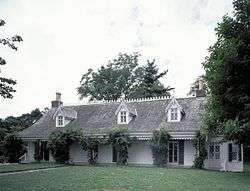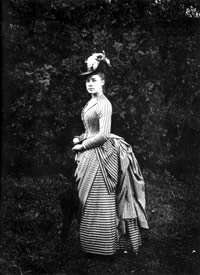Alice Austen
| Alice Austen | |
|---|---|
 Austen in Richmondtown, Staten Island on October 9, 1951, for her photo exhibition | |
| Born |
Elizabeth Alice Munn March 17, 1866 Staten Island |
| Died |
June 9, 1952 (aged 86) Staten Island |
| Resting place | Moravian Cemetery |
| Occupation | Photographer |
| Years active | 1880s - 1930s |
| Parent(s) | Alice Cornell Austen (1836-?) |

Elizabeth Alice Austen (March 17, 1866 – June 9, 1952) was a Staten Island photographer.[1][2]
Biography
Alice's father abandoned the family before she was born, and she was baptized under the name Elizabeth Alice Munn on May 23, 1866, in St. John's Church on Staten Island. She never used the name Munn and would initial her negatives with "EAA" for Elizabeth Alice Austen. With no household income and no husband, Alice's mother moved back to her own parent's home, which was known as Clear Comfort. Alice was the only child in the household, which now consisted of: Alice's mother, Alice Cornell Austen (1836-?); Alice's maternal grandparents, John Haggerty Austen (c1800-?) and Elizabeth Alice Townsend (c1800-?). Also in the house were her mother's siblings: Peter Austen, who was a chemistry professor at Rutgers University; and Mary Austen (1840-?) aka Minnie Austen, who was married to Oswald Müller (1840-?) who was the owner of a shipping company. Oswald was born in Denmark.
Clear Comfort

The house was built in the 17th century, but was expanded during the 19th century by Alice's grandparents: John Haggerty Austen; and Elizabeth Alice Townsend. Clear Comfort was dedicated as a National Historic Landmark on April 8, 1976, one month after the 110th anniversary of Alice's birth. It is also known as "Alice Austen House" and is located in the Rosebank neighborhood.[2][3]
Photography


Alice became interested in photography when her uncle, Oswald Müller, brought home a camera around 1876. Alice's uncle Peter Townsend Austen was a chemistry professor at Rutgers who taught her photographic processing. Peter and Oswald converted a closet on the second floor into Alice's darkroom. The earliest extant photograph by her is dated 1884. Over the next 40 years she produced around 8,000 photographs.[4]
Austen's subject was daily life of the people of New York. She documented upper middle-class society on Staten Island and lower-class people living in New York's Lower East Side. Her images of immigrants showed "a hesitancy and curiosity experienced by both photographer and subject." [5]
Household
By 1900 her uncle Oswald was the head of household and the family had two servants: Katherine Wertz (1857-?); and Constance Rasmusth (1876-?). They also had a cook, Mary McDonald (1873-?).
Gertrude Amelia Tate
In 1899 Alice met Gertrude Amelia Tate (1871–1962), a kindergarten teacher and dancing instructor of Brooklyn, New York. She became Alice's lifelong companion. Gertrude visited Alice regularly and they spent holidays together in Europe. She moved in with Alice at Clear Comfort in 1917, overriding her family's objection over her "wrong devotion" to Alice.[6]
Decline
Alice lived off the interest from the money left by her grandfather but the principal was lost in the Wall Street Crash of 1929, and by age 63, she had no income. She began to sell off her silver, art works, and furniture to get enough money to buy food and fuel. She then took out a mortgage on the house which was taken by the bank in 1945. She sold her remaining possessions for $600 to a second-hand dealer from New Jersey and called her friend Loring McMillen from the Staten Island Historical Society to take the photos. He stored them at the Third County Courthouse in Richmondtown. She then moved to an apartment then a nursing home. On June 24, 1950 she was declared a pauper and was admitted to New York City Farm Colony, Staten Island's poorhouse.
Rediscovery
In 1950 Picture Press started a project on the history of American women and contacted archives for unpublished images. C. Copes Brinley of the Staten Island Historical Society had 3,500 extant, uncatalogued Alice Austen glass plate negatives of the roughly 8,000 she took.[4] In October 1950, Constance Foulk Robert met with Brinley and McMillen to take a look at the negatives. Oliver Jensen came along on the next trip and he published several of the photos in his book Revolt of Women. He also wrote an eight-page story in Life magazine, and he published six-pages of travel photos in Holiday magazine. The publications raised more than $4,000 for Alice Austen and she was able to move out of the Farm Colony and into a private nursing home. On October 9, 1951 Alice Austen was the guest of honor at the first Alice Austen Day. She said: "I am happy that what was once so much pleasure for me turns out now to be a pleasure for other people."[7]
Death and burial
Alice continued to be supported by the Staten Island Historical Society and lived the next eight months in the nursing home, where she died on June 9, 1952. The Society arranged for her funeral and she was buried in the Austen family plot in the Moravian Cemetery at New Dorp, Staten Island.[1]
The Alice Austen Collection
The Staten Island Historical Society at Historic Richmond owns over 7,000 original items (glass plate negatives, film base negatives, and original prints) by Alice Austen.[8] This collection is cataloged, digitized, and stored in an archival manner at Historic Richmond Town, and it is available for study by appointment. The Alice Austen House Museum also has a collection of photographs. And about 300 are on display in the resource room, which is open to the public.
Timeline
- 1866 Birth and baptism
- 1917 Gertrude Tate moves in
- 1929 Stock market crash
- 1950 Declared a pauper then her rediscovery
- 1951 Alice Austen day
- 1952 Death
- 1976 Clear Comfort becomes National Landmark
Legacy
The Alice Austen School, PS 60, located on Merril Avenue in the Bulls Head neighborhood of Staten Island, is named in her honor.[9] Playwright Robin Rice's drama Alice in Black and White traces Alice Austen's life from 1876 to 1951. [10] The play also follows Oliver Jensen's search for and discovery of Alice and her glass plate negatives. The play received a world premiere at the Kentucky Center followed by a New York City premiere at 59E59 Theaters in 2016, the 150th anniversary of Austen's birth. (Both productions with Looking for Lilith Theatre Company). The play won the StageWrite Women's Theatre Initiative Award.
References
- 1 2 "Miss Alice Austen, 86 Photographer". New York Times. June 10, 1952. Retrieved 2008-06-26.
- 1 2 Claire Wilson (March 12, 2006). "Rosebank, Staten Island: A Quiet Slice of New York Waterfront". New York Times. Retrieved 2008-06-26.
Clear Comfort, the former home, now a museum, of Alice Austen, a native Staten Islander who was a pioneering female photographer.
- ↑ "Alice Austen House". National Park Service. 2007-01-23.
For 78 years, this was the home Elizabeth Alice Austen (1866-1952), a remarkable photographer whose work predates in subject matter and technique the photographs of other giants in the field. Austen began her career in the 1870s, and, although she used subjects as other women photographers of her time, her pictures have a realistic and natural edge rather than the blurry romantic view advocated by magazines of the time. Austen also veered away from the conventional studio poses; instead she took pictures of people during the course of their normal activities.
- 1 2 "Alice Austen House Museum". Historic House Trust. Retrieved 2008-08-05.
In 1877, at the age of 11, Austen received a camera from her uncle. She was immediately mesmerized by this new invention, and spent the next 40 years capturing some 8,000 images. She was often seen riding her bicycle around Staten Island and Manhattan, carrying almost 50 pounds of photographic equipment. Austen is best known for her street photography: photos of immigrants just off the boats from Ellis Island, street sweepers hard at work, postmen, bootblacks, and fishmongers. Her photographs bear witness to a strong aesthetic eye: she knew how to compose an image, what to include and leave out. Her artistic talents are evident in her photographs of nature, which were influenced by 19th-century ideas of nature as holder of both beauty and spirit.
- ↑ Dejardin, Fiona. "Austin, Alice". Grove Art Online. Oxford Art Online. Oxford University Press. Retrieved 1 February 2014.
As an avid amateur photographer, she documented a social history of a bygone era. Her work, dating between the 1880s and 1930s, recorded a charming portrait of the genteel activities of upper middle-class society on Staten Island. Although her photographs primarily documented the everyday life of the wealthy inhabitants and friends of her home, Clear Comfort, which overlooked New York’s Upper Bay, she also produced a challenging series of images of New York’s Lower East Side. These ‘street types’ were published as a portfolio by the Albertype Company in 1896.
- ↑ http://aliceausten.org/her-life/ Accessed 1 February 2014.
- ↑ "Old Friends Honor Miss Alice Austen. Photographer For 50 years Has Her Day.". New York Times. October 8, 1951. Retrieved 2008-06-26.
- ↑ "Staten Island Historical Society Collections Database". IMLS Digital Collections and Content Project. Retrieved 28 January 2013.
- ↑ http://www.ps60.org/home
- ↑ "BWW-Review-ALICE-IN-BLACK-AND-WHITE-at-59E59-Theaters-is-Important-Theatre-Wonderfully-Presented-20160809". Retrieved 2015-06-04.
Further reading
- New York Times, October 6, 1951, page 12; "Alice Austen Day"
- ‘The Newly Discovered Picture World of Alice Austen: Great Woman Photographer Steps Out of the Past’, Life (24 Sept 1951), pp. 137–44
- H. Humphries and R. Benedict: ‘The Friends of Alice Austen: With a Portfolio of Historical Photographs’, Infinity (July 1967), pp. 4–31
- S. Khoudari: Looking the Shadows: The Life and Photography of Alice Austen (diss., New York, Sarah Lawrence College, 1993)
- M. Kreisel: American Women Photographers: A Selected and Annotated Bibliography (Westport and London, 1999)
- J. L. Roscio: Unpacking a Victorian Woman: Alice Austen and Photography of the Cult of Domesticity in Nineteenth Century America (diss., Buffalo, NY, State U., 2005)
External links
- Official Alice Austen Website
- Selected Austen images in the Staten Island Historical Society Online Collections Database
- FAQ - The Alice Austen Collection at Historic Richmond Town
- Findagrave: Alice Austen